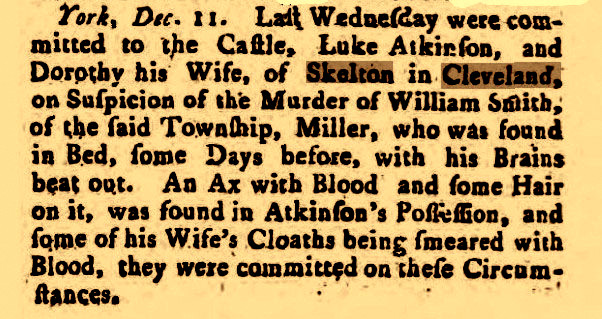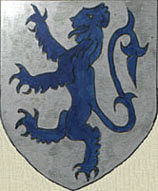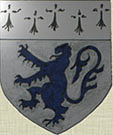
Parish Constable.
by Thomas Rowlandson.
|
THE "PARISH CONSTABLE".
It is rare to see a Policeman walking the streets of Skelton today.
Before 1856 it was impossible, as they did not exist until the North Riding Constabulary was established in that year.
There was a "Parish Constable", but he was just an untrained villager, who was elected annually by his fellows and not the Policeman that we know today.
It was a position that had existed in one form or another since ancient times and had many more responsibilities than just maintaining the peace.
Laws and Orders were issued by Kings and Government, but throughout English History it had been the duty of each Community to ensure that they were enacted.
Way back in Anglo-Saxon times villagers gathered at the "moot" of "Skel-tun" to conduct community business and appoint officials and representatives to attend the larger "shire" "moots" or meetings.
The Norman Conquest and the feudal system saw local control more in the hands of the occupant of Skelton Castle and the officials of his Manorial Court Leet.
The Skelton Court Leet was still meeting in 1881, regarding Skelton Estate matters, but centuries before that Church meetings of the Parish, called "the Vestry" gradually acquired the added responsibility of organising civil matters.
The Vestry each year appointed officials to carry out a multitude of tasks which the Elizabethan Poor Laws had imposed.
The Clerk received a salary, but the Overseers of the Poor and the Constable only expenses.
These duties had to be fulfilled in addition to earning a living at their own trades and the responsibility was often taken on reluctantly, as besides the many tasks there were legal penalties for neglecting to perform them.
|

Whipping Post on Skelton Cross Green.
|
The Justices of the Peace at the Quarter Sessions, which were held in the main towns of the North Riding appointed a paid Chief Constable and it was his job to ensure that the village Constables carried out their Orders.
One Order issued at Richmond, N Yorks in 1693 gives some idea of what was entailed:-
Constables neglecting their duties, or not setting up stocks or whipping posts sufficient for these uses, are to be fined according to the severity the law.
The Village Constable will take an Oath, to the following effect:-
1. Swear to serve the Monarch.
2. See that his Majesty's Peace is well kept.
3. Arrest armed offenders and commit Felons, Rogues, Vagabonds, Strowlers, Scouts, Thieves, Night-Walkers, Idle persons, Tipplers and Gamblers.
4. Levy 'Hue and Cry' and pursue until taken.
5. Make best endeavour that Watch and Ward be kept.
6. 'Hue and Cry' be raised against murderers, thieves and other felons.
7. The laws against rogues and vagabonds and idle persons be duly executed.
8. A watchful eye to be kept on innkeepers and frequenters thereof.
|

The Stocks stood by the Whipping Post on Skelton Cross Green until the early 1800s.
|
9. Restrain inordinate haunting and tippling in same.
10. Make a presentment of all concerned in bloodshedding affrays and outcries.
11. Once a year at Quarter Sessions present all Popish Recusants and their children above nine years old and also their servants, (those who absented themselves from the Services in the Parish Church).
12. Execute well and truly all warrants from Justices of the Peace against unlawful providing of provisions.
13. Cause all persons to meet to serve in corn and hay harvests.
14. In Easter Week see to the parishioners mending the highways.
The Whipping Post still stands on Skelton Cross Green and a 1906 Parish Magazine states that the stocks stood close by it "within living memory".
The above Order indicates that they were well used, but no reports of actual incidents seem to have survived to show how petty crime was dealt with in the 1600/1700s.
Northallerton Prison was not opened until 1783 and rather than imprisonment punishments were physical and fairly immediate, ranging from the stocks to public whippings [public whipping of women was stopped in 1817 and of men in 1830], transportation to the colonies and public executions.
|

Thomas Rowlandson's depiction of the condemned sitting on a Cart with their coffin on the way through Micklegate, York to the gallows.
|
In 1688 there were 50 offences on the statute book punishable by death. By 1776 that number had reached 200 and 220 by the end of the century.
The Law was made by the landed Gentry and was designed primarily to protect their property, but being a Catholic Priest, clipping coins, stealing sheep, even saying the wrong thing could all result in slow strangulation at the end of a rope and dancing on the air, while the crowd looked on for entertainment.
The population of Skelton before the opening of the Mines was only around 700, so the Parish Constables probably had few major offences to trouble them.
The only reports found of crimes committed in that period by Skelton folk, which were serious enough to be taken to the Quarter Sessions and York Assizes are:-
ASSAULT.
On the 18th April 1769 at the North Riding Quarter Session, held at Thirsk, John Hutchinson of Skelton in Cleveland, a blacksmith, was convicted of assaulting, beating and abusing William Sisterton, an Officer of the Customs in the execution of his duty. He was fined £50 and committed to York Castle, "until he be discharged by order of the the Court of Exchequer, pursuant to the statute of the 13th and 14th of King Charles II."
|

|
MURDER AND A PUBLIC HANGING.
On the 24TH November 1770 William Smith, a miller, was murdered at night in his bed at home in Skelton in Cleveland by Luke Atkinson who also lived in the village.
On Sunday evening Atkinson told Mr Wharton that he had without the least provocation for 3 weeks before the perpetration of the murder several times a strong inclination to commit it; but had always got the cruel thought driven from his mind, till the unhappy night in which he effected it, when he went to bed, but could not rest;
that he arose from out of his bed and fell to prayer, in hopes of diverting these thoughts; but so irresistible was the impulse, that he at last went to the house of William Smith armed with a mattock and hatchet, broke open the door with the mattock, and found him asleep in bed, where he struck him several times on the head, but whether with the mattock or hatchet he did not remember; and that afterwards he took the deceased's
|
purse containing one half guinea, a quarter guinea, about five shillings in silver and sixpence in copper.
Both Luke and his wife was initially charged with the crime, but he insisted that she was not involved and obtained her release.
On the 18th March 1771 Luke Atkinson was convicted of the murder of William Smith at York Assizes. He was publicly hanged on the "three legged Mare" gallows at York Tyburn, without Micklegate Bar.
He "died penitently" and his body was sent to the anatomists for dissection.
1801. In this year the Skelton Constable was John Wilkinson and in response to the threat of invasion by Napoleon the Nation's Constables were ordered to record all the males in their Parishes aged between 15 and 60, plus a mass of facts about their livestock, weapons and tools owned etc. Full details for Skelton can be read on the pages starting here
The Skelton Overseers of the Poor Account Book give an idea of the Constable's many other tasks:-
paying the County rates, removing people from the Parish who could become poor relief claimants, taking the mothers and fathers of bastards to Court so the child did not become a burden on the ratepayers, appointing a Deputy Constable, mending roads and bridges, listing of men in the Parish eligible to serve in the Militia, giving relief to poor people travelling through the Parish, taking the mentally disturbed to York Asylum, etc.
|
1822
20th March
12th Oct
19th Nov
17th Dec
20th Dec
27th Dec
31st Dec
1823
21st Jan
23rd Jan
4th Feb
4th Feb
11th Feb
20th April
1824
19th March
7th June
22nd July
5th Oct
14th Dec
16th Dec
17th Dec
17th Dec
1825
3rd Jan
28th Jan
30th Jan
1st Feb
24th Feb
15th March
30th March
1826
6th Feb
26th Feb
22nd March
20th March
26th July
21st Sep
Oct 5th
1829
10th Feb
10th Feb
1830
16th March
30th March
12th April
1831
30th Sep
1832
16th Feb
17th March
18th March
30th July
10th Aug
1833
21st March
|
Paid James Crusher, Constable, for taking in Names for the Militia
Paid for Justice Vagrant Order
Journey to Guisborough to attend Justice Meeting and paid for a Warrant to apprehend Amelia Williamson
Journey to Guisborough to get an Order to remove John Thompson
Journey to Linthorpe to remove John Thompson
Paid for William Wren's pony corn when seized by Bailiff
Paid James Crusher, Constable, Quarterly Money being the County Rate
Journey to Guisborough for Ann Hepton to Father her child
Paid sundry men for cutting Snow and other labour as per account
Paid for Summons to Amelia Williamson
Paid for Order of her Filiation
Journey to Guisborough for Summons for John Coates
Journey to Guisborough concerning Summons for Isaac Hutton and John Wright
Paid relief to 1 poor travelling woman with 2 children
Paid James Crusher for Ralph Weatherill to prevent his going to the House of Correction
Paid James Crusher, Constable, on John Thompson's account at Staithes, 5 shillings
Paid James Crusher for Ralph Weatherill's misbehaving
Journey to Guisborough to take out a Warrant to apprehend Richard Baker by order of John Wharton
Journey to Guisborough for a Summons for Richard Baker for disobeying an Order
Journey to Guisborough with Richard Baker and Stephen Kitching
Paid William Clark for Summons and Commitment for Richard Baker
Paid James Crusher, Constable, concerning Militia
Paid James Crusher on account of Elizabeth Roberts having more relief
Journey to Guisborough concerning Stephen Kitching's settlement
Paid for removal of Stephen Kitching and Wife to Growman Bridge
Journey to Guisborough concerning Stephen Kitching returning from his Parish to Skelton again after his removal
Paid James Crusher, Constable, for commitment of a man to Northallerton
Paid expenses on removal of Esther Judson to Guisborough
Paid James Crusher, Constable, to relieve a man from Bradford and his lodging night with victuals
Relieved William and Jane Davies of the 60th Regiment of Foot as casual Paupers
Paid to James Crusher, Constable, by an Order from the Quarter Sessions as a County Rate towards the Building and repairs of York Castle
Paid James Crusher for conveying John Carrick to Guisborough
Paid Robert Wilkinson, Constable, for relieving passengers
Paid relief to two ship-wrecked sailors
Paid William Lynas his "sallary" for being Deputy Constable
Paid Mr Hickson, Chief Constable, quarter year County Rate
Paid Mr Hickson, journey to Coatham to examine a Pauper
Paid William Watson, Constable, journey to Stockton, to serve a Summons on George Harrison for non-payment of his reliefs.
Paid Constable of Brotton for the repair of Wandale Bridge
Paid William Watson, Constable, his Bill for relieving paupers
Paid William Watson, Constable, for repairing Wandale Bridge, relieving passengers and journeys as per Note
Paid for a Warrant Commitment for Francis Hudson to convey him to the House of Correction for Elizabeth Lowe's child
Paid William Lynas for being sick and off work
Paid to ditto half of his "sallary" for standing as Deputy Constable and acting as police officer
Paid John Wood, Constable, his Bill for relieving passengers. Journeys to Guisborough etc
Paid Wilton Constable for going after Edward Charter
Paid John Wood, Constable, his Bill as per Note for quarter year,
|
2s 6d
2s 0d
2s 6d
1s 6d
6s 0d
£3 13s 6d
£6 13s 11d
1s 6d
3s 4d
2s 0d
7s 0d
1s 6d
3s 6d
1s 6d
13s 6d
5s 0d
5s 0d
1s 6d
1s 6d
1s 6d
4s 0d
1s 0d
1s 0d
2s 9d
£1 3s 0d
1s 6d
5s 0d
1s 0d
12s 0d
4s 0d
£23 2s 10d
2s 6d
5s 10d
6d
3s 0d
£18 18s 8d
2s 0d
2s 6d
7s 6d
12s 0d
£4 6s 0d
2s 6d
5s 0d
10s 0d
18s 2d
2s 0d
£1 11s 4d
|
The Work House System started in 1834, taking over much of the "care" of the Poor that had been the duty of the Parish Vestry officials and the Police Force was established in the North Riding of Yorkshire in 1856 to maintain the Law.
Even so villagers were still appointed after this to the role of Parish Constable. The office was not abolished until the "Parish Constables Act" of 1872.
The Parish Vestries lasted until 1894 when they were replaced by Parish and Urban District Councils.
|
|



